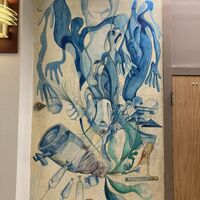-
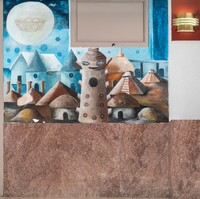 Architecture
Architecture Lacy’s mural illustrates houses from a variety of different civilizations and cultures. The center structure which appears to have a face is a depiction of the terracotta sculpture she created under the instruction of Professor Carroll Harris Simms. In the upper left there is a moon with a basket of eggs, symbolizing fertility and new life.
-
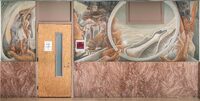 Awakening
Awakening Gordon’s mural shows the artist in various stages of her creative process, reflecting the influence of her TSU art professors. In the composition, she portrays herself sculpting a terracotta bison, throwing pottery at a wheel, weaving at a loom, and drawing at an easel. A wispy fabric runs through the mural, a motif in some of her other works.
-
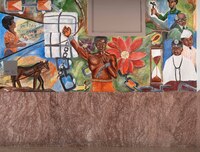 [unknown]
[unknown] This mural by an unknown student artist reflects themes of emancipation and progress. The central figure of a shirtless Black man raises his fist, while broken chains dangle from his waist. Bales of cotton and chains signify slavery in the mural, while, on the right, Black men in various professions represent changes brought by emancipation.
-
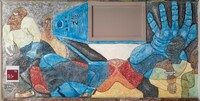 [unknown]
[unknown] Jones’ surrealist Hannah Hall mural depicts bald, one-eyed men conducting a television broadcast. The artist incorporated Hannah Hall’s architecture into the design, as the beige panel, where the camera lens would be, was a glass transom window when the mural was painted. Dr. Biggers urged students to carefully consider where to paint their murals.
-
 [unknown]
[unknown] Mills’ Hannah Hall mural reflects on white supremacist violence in the US and Black activism. Key political figures like Martin Luther King, Jr., Stokely Carmichael, John F. Kennedy, and Robert F. Kennedy appear throughout the mural. In the center, a man either lifts or pulls down the American flag to reveal or conceal hidden white supremacists.
 Architecture Lacy’s mural illustrates houses from a variety of different civilizations and cultures. The center structure which appears to have a face is a depiction of the terracotta sculpture she created under the instruction of Professor Carroll Harris Simms. In the upper left there is a moon with a basket of eggs, symbolizing fertility and new life.
Architecture Lacy’s mural illustrates houses from a variety of different civilizations and cultures. The center structure which appears to have a face is a depiction of the terracotta sculpture she created under the instruction of Professor Carroll Harris Simms. In the upper left there is a moon with a basket of eggs, symbolizing fertility and new life. Awakening Gordon’s mural shows the artist in various stages of her creative process, reflecting the influence of her TSU art professors. In the composition, she portrays herself sculpting a terracotta bison, throwing pottery at a wheel, weaving at a loom, and drawing at an easel. A wispy fabric runs through the mural, a motif in some of her other works.
Awakening Gordon’s mural shows the artist in various stages of her creative process, reflecting the influence of her TSU art professors. In the composition, she portrays herself sculpting a terracotta bison, throwing pottery at a wheel, weaving at a loom, and drawing at an easel. A wispy fabric runs through the mural, a motif in some of her other works. [unknown] This mural by an unknown student artist reflects themes of emancipation and progress. The central figure of a shirtless Black man raises his fist, while broken chains dangle from his waist. Bales of cotton and chains signify slavery in the mural, while, on the right, Black men in various professions represent changes brought by emancipation.
[unknown] This mural by an unknown student artist reflects themes of emancipation and progress. The central figure of a shirtless Black man raises his fist, while broken chains dangle from his waist. Bales of cotton and chains signify slavery in the mural, while, on the right, Black men in various professions represent changes brought by emancipation. [unknown] Jones’ surrealist Hannah Hall mural depicts bald, one-eyed men conducting a television broadcast. The artist incorporated Hannah Hall’s architecture into the design, as the beige panel, where the camera lens would be, was a glass transom window when the mural was painted. Dr. Biggers urged students to carefully consider where to paint their murals.
[unknown] Jones’ surrealist Hannah Hall mural depicts bald, one-eyed men conducting a television broadcast. The artist incorporated Hannah Hall’s architecture into the design, as the beige panel, where the camera lens would be, was a glass transom window when the mural was painted. Dr. Biggers urged students to carefully consider where to paint their murals. [unknown] Mills’ Hannah Hall mural reflects on white supremacist violence in the US and Black activism. Key political figures like Martin Luther King, Jr., Stokely Carmichael, John F. Kennedy, and Robert F. Kennedy appear throughout the mural. In the center, a man either lifts or pulls down the American flag to reveal or conceal hidden white supremacists.
[unknown] Mills’ Hannah Hall mural reflects on white supremacist violence in the US and Black activism. Key political figures like Martin Luther King, Jr., Stokely Carmichael, John F. Kennedy, and Robert F. Kennedy appear throughout the mural. In the center, a man either lifts or pulls down the American flag to reveal or conceal hidden white supremacists.